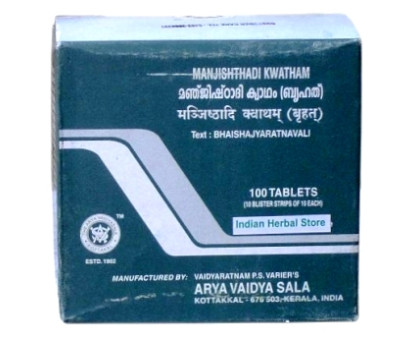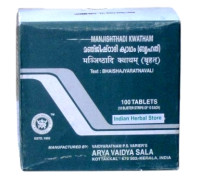
Manjishtadi kwath to złożony lek z tradycji ajurwedyjskiej Kerali, oparty na „klasycznej” formule Manjishta.
Manjishta jest uważana za najlepszy lek w tradycji ajurwedyjskiej na metabolizm i oczyszczanie krwi. Jest to jedno z głównych ziół, które skutecznie obniżają Pitta-dosha.
Manjishtadi kwath usuwa toksyny z krwiobiegu, zapobiega zakrzepicy i poprawia ogólne i miejscowe krążenie krwi. Dzięki swoim unikalnym właściwościom Manjishtadi kwath leczy uszkodzone tkanki, złamania kości, stymuluje resorpcję łagodnych i złośliwych nowotworów.
Jest doskonałym lekiem przeciwzapalnym w sferze ginekologicznej.
Manjishtadi kwath reguluje pracę głównych narządów wydalniczych, takich jak nerki, wątroba i śledziona, powodując doskonały efekt oczyszczający.
W przypadku wysypek i stanów zapalnych skóry Manjishtadi kwath jest stosowany miejscowo w postaci pasty miodowej.
W przypadku oparzeń skóry i uszkodzonych tkanek Manjishtadi kwath jest również stosowany miejscowo w postaci pasty lukrecjowej w celu złagodzenia bólu.
Manjishtadi kwath korzyści:
- silny środek oczyszczający, który stymuluje funkcję głównych narządów wydalniczych (wątroba, nerki, śledziona);
- doskonały środek przeciwzapalny w sferze ginekologicznej;
- jest pomocny w leczeniu łagodnych i złośliwych nowotworów ze względu na swoje właściwości oczyszczające i resorpcyjne;
- goi uszkodzone tkanki, złamania kości, poprawia ogólne i miejscowe krążenie krwi;
- hamuje aktywność opryszczki narządów płciowych.
Wskazania: brak miesiączki, bolesne miesiączkowanie, krwotok miesiączkowy, okres klimakterium, kamica moczowa, żółtaczka, wodobrzusze, paraliż, wysypki skórne, zakażenie opryszczką (typ I), złamania kości.
Treść:
Manjishtha – Rubia cordifolia, Musta – Cyperus rotundus, Kutaj – Holarrhena antidysenterica, Guduchi – Tinospora cordifolia, Erand – Ricinus communis, Sunthi – Zingiber officinale, Bharang – Clerodendrum serratum, Kantkari – Solanum surattense, Vacha – Acorus calamus, Nimba – Azadirachta indica, Haridra – Curcuma longa, Daruharidra – Berberis aristata, Haritaki – Terminalia chebula, Bibhitak – Terminalia belerica, Amalaki – Emblica officinalis, Patola - Trichosanthes dioica, Katuki – Picrorhiza kurroa, Royle Nasottar – Operculina turpethum, Vidang – Embelia ribes, Asana – Pterocarpus marsupium, Chitrak – Plumbago zeylanica, Shatavari – Asparagus recemosus, Trayman – Gentina kurroo, Pippali - Piper longum, Indrajav - Holarrhena antidysenterica, Vasa - Adhatoda vasica, Bhringraj - Eclipta alba, Devdaru - Cedrus deodara, Patha - Cissampelos pareira, Khadira - akacja katechu, Varun - Crataeva nurvala, Kalmegha - Andographis paniculeta, Bakuchi - Psoralea corylifolia, Aragvadha - przetoka Cassia, Shakothak - Streblus asper Bakayan, Nimb - Melia azedarach, Karanj - Pongomia pinnata, Ushir - Vetiveria zizanioides, Indravaruni - Citrullus colocynthis, Anatmul - Hemidesmus indicus, Parpatak - Fumaria, Kutaj - Holarrhena antidysenterica parviflora, Guduchi - Tinospora cordifolia.
Dawkowanie/Stosowanie:
1 tabletka dwa razy dziennie lub zgodnie z zaleceniami lekarza lekarz.
Ten środek nie jest produktem medycyny alopatycznej. Przeważnie jest uważany za suplement diety, który można stosować wyłącznie jako dodatek do diety. Wszystkie informacje na temat leczenia chorób tym produktem opierają się na wiedzy z zakresu ajurwedy, fitoterapii i odżywiania i nie są potwierdzone przez ukraińskie Ministerstwo Zdrowia ani inne kompetentne organizacje i mogą być wykorzystywane wyłącznie w celach informacyjnych.

